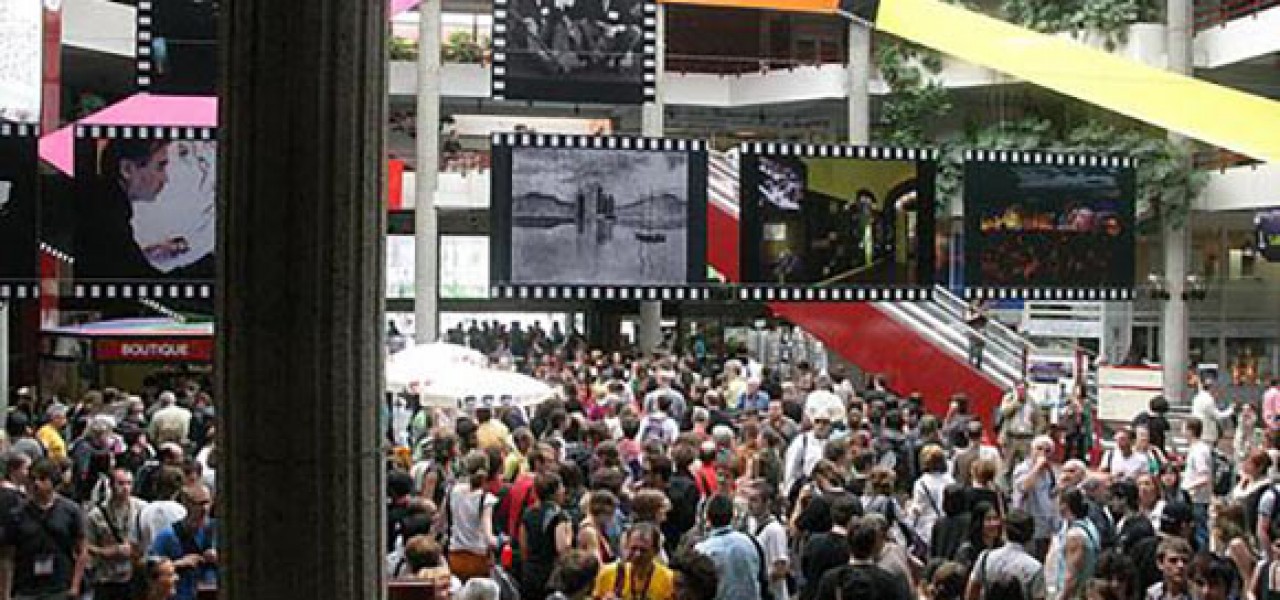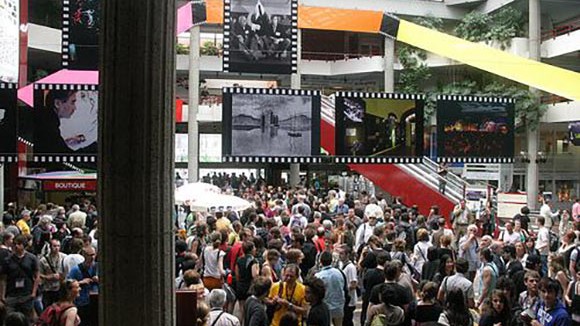

As Animation Booms Globally, So Does Annecy

The comics industry has San Diego Comic-Con, animators have Annecy. First held in 1960, the Annecy International Animation Film Festival is not only the world’s oldest animation festival, it is also the biggest, by a wide margin.
Beginning today, a record-breaking 7,700-plus attendees will descend on the French alpine resort town of Annecy for a weeks’ worth of film screenings, conferences, workshops, and the important International Animation Film Market (Mifa), celebrating its 30th anniversary this year.
Cartoon Brew conducted a joint-interview by telephone with Marcel Jean, the Annecy festival’s artistic director, and Mickaël Marin, the head of Mifa, about the festival’s unique acknowledgement of women animators, the booming global animation market, the importance of government investment in industry infrastructure, and the growing number of Los Angeles artists who attend the festival every year.
Cartoon Brew: Annecy has shined a major spotlight on women animators this year, including an all-women jury, numerous screenings devoted to films by women, and an honorary Cristal award to Florence Miailhe. What inspired this focus on women filmmakers?
Marcel Jean: When I was appointed here, I already had an idea at the time to place a spotlight on women in animation. There was an important moment a few years ago on the Internet, when there appeared an old letter written by the Disney studio to young women who wanted to work there. To me, there has been clear discrimination in all of the studios, not just Disney, for years. So my question was, “What is the situation now?”
Even here, I have a selection committee of four men; there are no women on the Annecy selection committee. It was a preoccupation of mine to make sure that we were fair in our evaluation of the films that were made by women, so I asked my colleagues to do some statistics on film submissions. We soon realized that around 28-30 percent of the short films submitted to the festival were made by women, which is far from a real equity. We also realized that about 50 percent of the student films were made entirely by women, or a team of students including women filmmakers, so my reflection was that this situation was about to change in the world of animation. For me, it was important to take a sort of Polaroid of the actual situation, to look both at the history of women in animation, and their place right now. This is what I wanted to do.

Cartoon Brew: What are some of the other highlights of the women’s spotlight?
Marcel Jean: There are some special programs, including two retrospectives, including one of Stacey Steers‘s work. It was important to me to find a woman filmmaker who wasn’t as well known in the world of animation. Stacey Steers is an interesting case, because she was very active in the world of experimental film and contemporary art but still relatively unknown in animation, despite being an animator. There is also a retrospective of Janet Perlman, who is interesting because she has been making cartoon films since the mid-1970s. At that time, there were very few women who made funny animation; most of the films that were made by women at that period, and even into the 1980s, were very serious, let’s say more mature films that wanted to say something about the condition of women, maternity, and family life. And so it was very interesting for me to look at the work of a women animator who was in the middle of the man’s world of animation, in the heart of the funny, cartoon films.
There is also a third retrospective of Florence Miailhe’s work, who will be awarded an Honorary Cristal, the third we have given at Annecy. The first was given to Jerzy Kucia and the second last year to Isao Takahata, so it was important for us this year to find a woman. The role that Florence Miailhe has played in French animation for more than 25 years is crucial. She’s an inspirational filmmaker but she is also a teacher, and a large number of young filmmakers have had Florence as their teacher, so it was important to put the spotlight on her.
Cartoon Brew: Let’s switch gears and talk about Hollywood coming to Annecy. Over the last decade, I’ve noticed a substantial increase in the number of artists who come from Los Angeles to the festival. Is there a conscious effort on the part of Annecy to work more closely with the industry or has it been an organic growth?
Marcel Jean: I would say it’s a mix of the two. Mickaël Marin and I have been aggressive in building relationships in Hollywood and San Francisco. Every year, we take a trip there together to talk about the festival and Mifa, to try and help them understand the real dimension of Annecy and make them realize there are multiple levels of benefit. There are clear possibilities to present their work but also to connect with other studios and recruit artists from other countries.
Mickaël Marin: Yes, if we are talking about television, there are opportunities to find partners and producers. And producers can find new partners and content here for sure. We have noticed an increase in their presence, and for me, it’s just the beginning. Annecy is the perfect place, and perfect tool, for the United States to choose, and we feel the same about Canada, especially on Mifa’s side, where we have a much larger Canadian presence recently.
Marcel Jean: Next November, we are also planning to go to Portland, Oregon for the first time. So we really think there is a place for development in our relationships with people in the United States. We are doing the same kind of work in Asia, South Africa, and South America. Every year, someone from Mifa goes to Argentina or Brazil or Mexico; since I was appointed, I have visited South Korea and Japan. It’s very important to us for Annecy to go worldwide and to be dynamic in our relations with people from all over the world.
At the same time, I don’t think there was ever more experimental film at Annecy than there is right now. There are more big things arriving from the major studios in Hollywood and Japan, but there are also more short, experimental films than ever before. So it is not a battle between the big studios and the independent filmmakers. We are really seeing complementarity between different formats and ways of working in the animation world.

Cartoon Brew: Mickaël, this is the biggest Mifa ever. Where do you see most of that growth coming from?
Mickaël Marin:There are for sure more players in the game, which has become much more international. I think we have seen at the festival that South America is growing; the last two Cristals for feature films were won by Brazil. At the market, we have delegations from Colombia, Chile, Mexico, and Argentina, so South America for sure is developing a place within the global animation industry. Africa will likely be next; we have South Africa, but we see other territories growing. We’ve created a pitching session called “Animation du Monde,” or “Animation From the World,” to help new talents coming from places like Africa.
Cartoon Brew: One of the Mifa pitch sessions this year is entirely devoted to South Africa…
Mickaël Marin: Yes, we work closely with the French embassy over there and want to promote new cinema and talent from that region. We do the same in Indonesia, Madagascar, and Georgia. It’s just beginning; we developed the new concept for the pitch session this year, and will open it up to more countries next year. But the idea is to give their projects the same level of consultancy and visibility as French or American projects, and to help them make the right connections at Mifa.
Cartoon Brew: I’ve noticed that some Asian countries, such as Singapore, invest a lot of money into their animation, while others in South America don’t have that luxury to invest in the animation sector. How important, from your perspective, is government support for developing a country’s animation infrastructure?
Mickaël Marin: It’s crucial. When the Mifa market was created in 1985, it was related to a government plan to develop the audiovisual sector. The idea was to help create an animation industry and market in France. Thirty years later, France is an international animation leader in Europe, and the third largest animation producer in the world. It’s crucial for the animation industry and for culture when you have a government that invests money. Every year, we can notice a difference when national or regional agencies help their local talent come to Annecy. It really makes a difference.

Cartoon Brew: One concern I notice among those I speak to in developing animation countries is the worry that they will become service studios rather than creators of content. At Mifa, have you noticed studios from developing countries pushing to do service work, or are they more interested in pitching their own ideas?
Mickaël Marin: My feeling is that, for example, many South American countries will go directly to creating their own content and IPs. On the other hand, in some Asian countries, they were first service companies that moved later into developing their own content. The crucial point is education—strong schools who teach their students how to create, write, and animate their stories. America, France, Germany and other countries are strong in animation because they have highly skilled schools. Because it’s an ecosystem: It works here because you have schools, you have the government and regional funds investing in co-productions, and broadcasters that are required to invest in animation co-production. Countries who set up this kind of animation ecosystem will for sure find success and build a real industry.
Cartoon Brew: Do you have any advice for first-time attendees? How can they get the most out of the experience?
Marcel Jean: You know, there are so many things to do at the festival, so many different screenings and programs. You can have a completely different experience at Annecy, depending on your interests. For example, we haven’t talked yet about the spotlight on Spanish animation. There will be a retrospective on the history of Spanish animation at Annecy this year that is certainly the most important retrospective ever organized about their animation cinematography. Some attendees will experience this, while others will not see a single Spanish animation program, yet they can have a strong experience too.
My personal point of view on festivals is that we must work very hard to develop events that are unique. These days it’s possible to watch films on web platforms, so you can’t justify coming to a festival just to watch films. You must take advantage of all the benefits of a festival: to meet with people, to go see filmmakers and producers talk about their work, to watch works-in-progress, to understand the creative process of different artists. This is what we’re trying to offer at Annecy. I would recommend to somebody who’s attending for the first time to make sure that they will attend at least one or two of these encounters.

